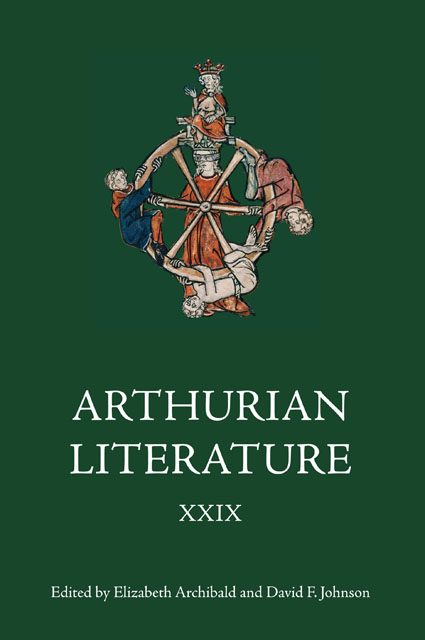Book contents
- Frontmatter
- Contents
- List of Illustrations
- General Editors’ Foreword
- List of Contributors
- I Edward III’s Abandoned Order of the Round Table
- II King Arthur’s Tomb at Glastonbury: The Relocation of 1368 in Context
- III Benedict of Gloucester’s Vita Sancti Dubricii: An Edition and Translation
- IV New Evidence for an Interest in Arthurian Literature in the Dutch Low Countries in the Fifteenth and Early Sixteenth Centuries
- V Malory’s Source-Manuscript for the First Tale of Le Morte Darthur
- VI Malory’s Sources – and Arthur’s Sisters – Revisited
- VII Peace, Justice and Retinue-Building in Malory’s ‘The Tale of Sir Gareth of Orkney’
- VIII Mapping Malory’s Morte: The (Physical) Place and (Narrative) Space of Cornwall
- IX The Fringes of Arthurian Fiction
- Contents of Previous Volumes
II - King Arthur’s Tomb at Glastonbury: The Relocation of 1368 in Context
Published online by Cambridge University Press: 14 February 2023
- Frontmatter
- Contents
- List of Illustrations
- General Editors’ Foreword
- List of Contributors
- I Edward III’s Abandoned Order of the Round Table
- II King Arthur’s Tomb at Glastonbury: The Relocation of 1368 in Context
- III Benedict of Gloucester’s Vita Sancti Dubricii: An Edition and Translation
- IV New Evidence for an Interest in Arthurian Literature in the Dutch Low Countries in the Fifteenth and Early Sixteenth Centuries
- V Malory’s Source-Manuscript for the First Tale of Le Morte Darthur
- VI Malory’s Sources – and Arthur’s Sisters – Revisited
- VII Peace, Justice and Retinue-Building in Malory’s ‘The Tale of Sir Gareth of Orkney’
- VIII Mapping Malory’s Morte: The (Physical) Place and (Narrative) Space of Cornwall
- IX The Fringes of Arthurian Fiction
- Contents of Previous Volumes
Summary
For 350 years, the monument said to contain the bones of King Arthur and Queen Guenevere was an exceptional feature of Glastonbury abbey’s rich topography. Arthur may have been only the 106th ruler in a line of succession from Brutus, but he was the earliest to have a recognized tomb in a realm and a culture obsessed with monarchy and monarchs’ restingplaces. The monument’s presence at the heart of a thriving, often militant institution suggests its enduring value for monastic esprit de corps, over and above the occasional forensic use made of it by kings, historians and polemicists. This value was essentially temporal in nature: Arthur may have consorted with saints – the monks could show their guests a crystal cross given him by the Virgin Mary – but it seems exceedingly unlikely that anybody ever prayed to him or his consort for intercession. Remains of both were set aside after the tomb was opened in 1278 ‘propter populi deuocionem’, but this is no imputation of holiness, and must anyway be reckoned against the absence of relics of either figure from the abbey’s highly detailed relic-lists, and also the intrinsic improbability that such a beacon of religion as Glastonbury would confuse the categories of secular hero and saint. All of the kings buried at Glastonbury are named in the extensive fourteenth-century list of saints’ resting places in England contained in London, Lambeth Palace Library MS 99 (at fol. 194v). But their inclusion in this list, which was not made at Glastonbury, reflects only the fact that they were considered a remarkable ensemble: none is called ‘sanctus’, as the other male saints in the list are. (Guenevere is omitted.) Arthur’s main value for the monks was that of a championgiant perpetually in their midst, who, if not actually the first founder of their monastery, was nevertheless understood as a founder in the extended sense of the term used in the later Middle Ages. His presence, and that of Guenevere, lent non-specific but conspicuous weight to claims to property, privilege and a matchless antiquity.
The tomb made for the remains of Arthur and Guenevere after their exhumation in 1191, from which they must have been expected to rise at the Last Judgement, was relocated within the abbey church two or three times.
- Type
- Chapter
- Information
- Arthurian Literature XXIX , pp. 41 - 52Publisher: Boydell & BrewerPrint publication year: 2012
- 10
- Cited by

